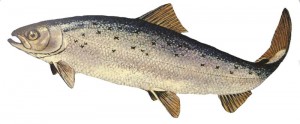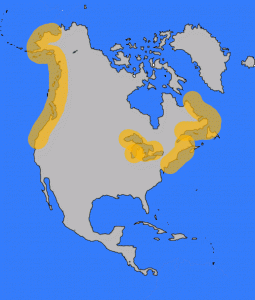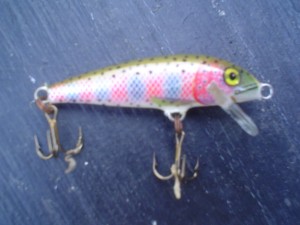Get ready for a show. Salmon are known to put on quite the acrobatic display once on the line. They also offer a very aggressive fight. Salmon are very similar to trout in regards to fishing methods and often times trout are caught directly alongside trout. Many stocked ponds have species of trout and salmon that are caught side by side. Many “opening day” anglers mistakenly catch Salmon while on the pursuit of rainbow, brown or brook trout. The key to fishing any particular species is understanding the facts about them, so listed below are some common salmon fishing facts.

Salmon Fishing Facts
Salmon come in a variety of species that can be broken down into two categories, Atlantic Salmon and Pacific Salmon. Their is only one real species within the Atlantic ocean and it is referred to as the Atlantic Salmon. The Pacific Salmon however can be subdivided into the following species, Cherry Salmon, Chinook Salmon, Chum Salmon, Coho Salmon, Pink Salmon and Sockeye Salmon. The tactics used to catch salmon are fairly similar across all species, with slight variations.
Salmon can grow as large as 75 lbs and almost 5 feet long. They are an anadromous species which means that they spend half of their time in fresh water and the other half in saltwater. They spawn in freshwater rivers and lakes where they will travel vast distances to get to their original spawning ground. Much science has been conducted as to how the salmon finds its way back to its original spawning ground and many believe that they have a very keen sense of smell and use that to navigate to their original place of birth. Not all species are anadromous as some are land locked and spend their entire lives in lakes and ponds and have adapted their spawning habits to compensate.
When small salmon feed on small insects and crustaceans and as they grow larger eventually work thier way up the food chain.
Where to catch Salmon

In General the coasts of the North Atlantic and North Pacific are good areas to catch Salmon. They can also be caught in the great lakes region (Lake Ontario, Lake Michigan and Lake Superior). On the Atlantic coastline they can be fished for from Long Island all the way north to Ungava Bay Canada. You can also catch them while spawning where they can be easily spotted leaping small waterfalls, dams and other obstacles. Many local ponds and lakes are also stocked with Salmon so be sure to check you local DEM’s websites.
Here is a list of specic areas where you can catch Salmon
How to catch Salmon
As stated above salmon can be caught with many of the same tactics used to catch trout. You way want to use larger bait or lures however as salmon can grow larger than the common trout you find in rivers and streams. Here are some rigs you can use to catch salmon.
- Using live bait fishing near the top of the water when you know salmon are on that area. An eagle claw hook, which a dober attached a few feet up is a good simple method. You can bait with Shiner, Alewives or smelts. Worms are also effective.
- Using live bait with a similar rig fishing near the bottom of the water when you know salmon are at the bottom. Just use a weight in place of the dober obviously.
The standard three way rig is another tactic to use. This is accomplished by placing the weight at the bottom of the line and then creating a dropper loop a few feet from the bottom of your line. Attach the eagle claw hook baited with shiner to the dropper loop. Trolling or casting with lures, spoons and plugs is another popular method. Use larger lures and plugs to attract the larger fish.River fishing from shore is yet another popular method implemented. Look for areas where the salmon can hide behind the rushing current. The eddy’s formed from large rocks are generally a good location. They will hide there and wait to ambush their prey. Fly Casting is probably one of the most popular (and elegant) methods used to catch larger salmon. Wet flies and Dry flies can be used.When is the best time to catch salmonSpawning Salmon
I have found that fishing the early morning or late evening produces the best results when fishing for salmon, however they can be caught at all times of the day. Their annually migration on the east coast is from October through December so they can be easily spotted at these times. Many anglers believe that they are not very hungry during their spawning season however. It is a beautiful spectacle to watch however.
Salmon Fishing Tips
- Like all species, pay attention to their feeding habits, understand what they are feeding on naturally.
- Salmon have a very acute sense of smell. Take advantage of this by using baits that have strong smells.
- I have found that bright lures in the middle column of water work best for me when fishing for salmon. I have had much luck with yellow rooster tails at certain times of the season.
- Dry flies in may have produced numerous large fish in my experience.
- Larger deep diving spoons later in the season have also yielded positive results.


